Diseases and pests of cedar

Many owners of private houses with an extensive local area decorate it with conifers, including cedar. But this tree, like any others, is susceptible to various diseases and pest attacks. To save the green handsome man, you need to be able to notice the first signs of ailments in time and deal with them correctly.
Causes of diseases
Perennial cedar is a tree with a majestic crown, a developed root system and a strong trunk. It has good immunity, therefore it is very resistant to various kinds of diseases. However, at different periods of its growth and development, it can still be overcome by some problems. So, a one-year-old seedling purchased in a nursery and transplanted to a new place on your site will experience incredible stress at first, due to which its protective functions will be significantly weakened, and this can lead to active attacks by tree parasites.
In addition, a young tree may begin to emit a scent peculiar to it in the spring. This individual smell will entail increased interest from various insects and beetles.
With age, the cedar tree is also capable of losing stamina, so it can be affected by various diseases. This is mainly due to the violation of the rules of maintenance and care.

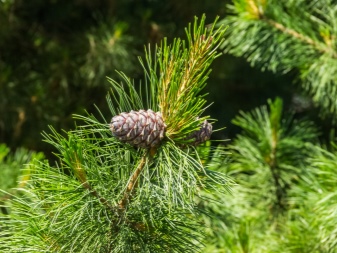
Common diseases
Dangerous for cedar trees are diseases such as rust and seryanka, which is also called "resin cancer". The first type of ailment is a fungal disease, which is characterized by the appearance of a white bloom on the cedar... First of all, the kidneys are affected, then, if therapeutic measures were not taken in time, the spores rapidly begin to move to young shoots and branches, and after a short period of time, the disease can be replaced on the trunk. As a result of this, the tree that has recently delighted with greenery begins to dry out, loses its vitality, and the needles fall off.
Rust visually it is yellow bubbles gradually turning into a white powder. The disease spreads most actively in warm and humid weather, and the main carriers are weeds growing nearby, which must be disposed of in a timely manner. Tar cancer is the most dangerous disease for cedar. This ailment is provoked by the rust fungi Peridermium pini and Cronartium flaccidum, which affect not only needles and bark, but also cambium and bast. Such a disease significantly weakens the immunity of the tree, as a result of which it can no longer cope with pests and diseases on its own and soon dies.
You can find out that the cedar is sick by uncharacteristic formations that begin to appear on the branches and trunk. They are called "ecidia" - bowl-shaped depressions that are filled with an orange or yellow-gray mass of spores (ecidiospores). It will not be possible to cure this ailment even with well-known antifungal agents, therefore the affected tree will have to be cut down and burned.
Therefore, it is important to deal with treatment immediately, when the first signs appear. The named rust fungi, in addition to conifers, can affect currant and gooseberry bushes, so it is not recommended to plant these flora representatives next to them.
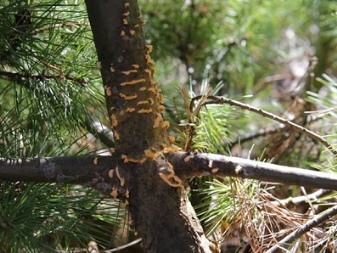
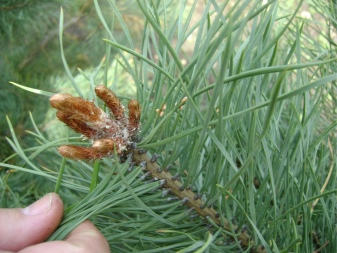
Pest overview
All kinds of wood pests, which also need to be dealt with in a timely manner, also have a negative effect on the health of the cedar.
- Spruce mite... If it appears, then the needles begin to fade, as it were, wrinkle, and subsequently dry out altogether. This is due to the fact that miniature parasites feed on the juice of young needles.
- Spider mite... Judging by the name, it can be understood that a characteristic sign of defeat is the appearance of a thin web on the needles. At the same time, the needles also turn yellow and dry.
- Pine aphid. It is a small (up to 5 mm) insect that feeds on the sap of young needles. Such parasites attack branches and needles not singly, but in groups, as a result of which the tree quickly loses its vitality.
- Small spruce false shield. This unpleasant insect is also small in size and usually settles at the bases of young shoots, provoking an intensive fall of the needles. Novice summer residents and gardeners may not even notice this pest at first, since in appearance it resembles an ordinary (slightly swollen) kidney. In addition to the active suction of juice, the fatal consequences are due to the release of honeydew by insects, which becomes an attractive breeding ground for sooty fungi. They, in turn, spoil the appearance of the plant (the tree becomes ugly, as if smoky) and interfere with the normal process of photosynthesis.
- Hermewith. It is a hemi-winged insect with a body length of only 2-3 mm, which is covered with white soft hairs. Colonies of these pests can be recognized by the appearance of dirty-white fluffy lumps on the needles. The purpose of their settlement is to consume the juice of cedar needles. Only young seedlings are affected - a perennial tree staunchly resists the influence of Hermes.
- Scoop. This pest butterfly is dangerous in that it eats cedar needles and sucks out the contents of the kidneys. An insect attacks trees with the onset of warmth, that is, in spring, the most active period occurs in May.
- Moth. This species of butterflies, as such, does not pose a danger to the cedar, which cannot be said about its larvae. It becomes more active in the last days of May, when it lays its eggs. Caterpillars appear around the middle of August and completely destroy all needles, as well as buds.
- Shootworm silkworm... This is a butterfly, the larvae of which also have a negative effect on the vital activity of the cedar. They penetrate the buds and young shoots of the tree, completely sucking out their contents. As a result, the tips of the branches are deformed, which leads to the curvature of the trunks, their multi-peakedness, and this greatly spoils the decorative appearance of the tree.
- Bark beetle... This pest, judging by the name, affects the cedar bark. It penetrates deeply, making holes where it lays eggs.
It is impossible to notice the larvae during external examination, but the presence of an insect can be determined by the characteristic holes and swollen bark, partially resinous deposits and a light brown powdery coating around.
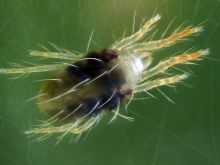
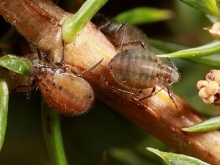
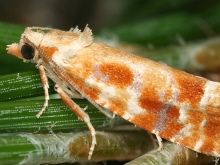
Treatment methods
To combat wood pests and diseases, various means are used: both proven purchased and folk. Without them, the tree may not survive the attack and die.
- Rust diseases... For the treatment of ailments of this type, fungicidal preparations are used. Stem injections can also be helpful.
- Seryanka (resin cancer). Unfortunately, there are no drugs for this disease, or rather, none of the available ones can cope with it. Therefore, the infected tree will only have to be dug up and burned. This must be done in order to protect other green representatives of the garden from the misfortune.
- Spruce mite. Regular treatments with Fitoverm will help to cope with this parasite. There is no point in treating folk remedies, since the tick is very resistant to them.
- Spider mite... "Fufanon" will be able to kill this pest, which should be bred strictly according to the instructions.
- Aphid. You can get rid of this unexpected guest with the help of "Karbofos", the solution of which must be irrigated several times with an interval of 10 days.
- Small spruce false shield... Insecticidal drugs are what will help in the extermination of these parasites, but only if their colonies are insignificant. When the whole cedar is damaged, treatments are carried out with stronger agents, for example, "Lepidocide".
- Hermes. In this case, "Iskra" (implies per needle processing), "Fufanon" and "Aktara" will be effective.
- Scoop. The larvae of this butterfly will help to destroy the three-time treatment with "Lepidocide".
- Moth. This is where insecticidal preparations come into play again. Irrigation with these means must be carried out at least 3-4 times.
- Shootworm silkworm. Unfortunately, it will not be possible to save the affected parts of the tree - they will have to be completely removed and burned, and the remaining places should be treated with Fastak.
- Bark beetle... The fight against this pest involves annual treatment with special means: "Confidor", "Clipper", "Antizhuk", "Wood doctor" and others.
If you cannot cope on your own, then it is recommended to contact specialized services.
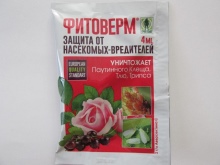
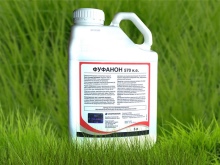

Prevention measures
Prevention is what will help maintain the health and appearance of cedar. It consists in proper care and regular treatments.
- Irrigation with insecticidal preparations should be carried out at least 3 times per season, while the first procedure is performed in early spring, before all pests are activated.
- Cedar is very sensitive to high humidity, therefore, waterlogging of the soil in the area should be avoided.
- Plants, flowers, trees and herbs planted nearby will help scare away harmful parasites from the coniferous representative: lavender, sage, mint, marigolds, castor oil plants, rue, walnuts.
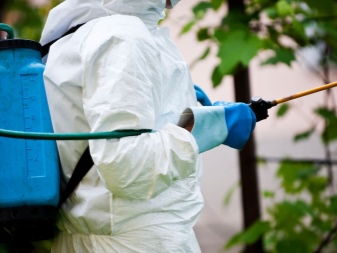
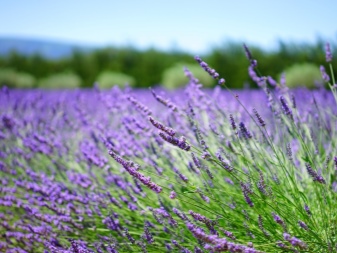
In the next video, you will find additional information about the diseases and pests of cedar.



































































The comment was sent successfully.